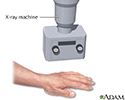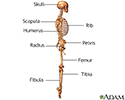X-ray - skeleton
Skeletal survey
A skeletal x-ray is an imaging test used to look at the bones. It is used to detect fractures, tumors, or conditions that cause wearing away (degeneration) of the bone.
How the Test is Performed
The test is done in a hospital radiology department or in the health care provider's office by an x-ray technologist.
You will lie on a table or stand in front of the x-ray machine, depending on the bone that is injured. You may be asked to change position so that different x-ray views can be taken.
The x-ray particles pass through the body. A computer or special film records the images.
Structures that are dense (such as bone) will block most of the x-ray particles. These areas will appear white. Metal and contrast media (special dye used to highlight areas of the body) will also appear white. Structures containing air will be black. Muscle, fat, and fluid will appear as shades of gray.
How to Prepare for the Test
Tell the provider if you are pregnant. You must remove all jewelry before the x-ray.
How the Test will Feel
The x-rays are painless. Changing positions and moving the injured area for different x-ray views may be uncomfortable. If the whole skeleton is being imaged, the test most often takes 1 hour or more.
Why the Test is Performed
This test is used to look for:
- Fractures or broken bone
- Cancer that has spread to other areas of the body
- Osteomyelitis (inflammation of the bone caused by an infection)
- Bone damage due to trauma (such as an auto accident) or degenerative conditions
- Abnormalities in the soft tissue around the bone
What Abnormal Results Mean
Abnormal findings include:
- Fractures
- Bone tumors
- Degenerative bone conditions
- Osteomyelitis
Risks
There is low radiation exposure. X-rays machines are set to provide the smallest amount of radiation exposure needed to produce the image. Most experts feel that the risk is low compared with the benefits.
Children and the fetuses of pregnant women are more sensitive to the risks of the x-ray. A protective shield may be worn over areas not being scanned.
References
Contreras F, Perez J, Jose J. Imaging overview. In: Miller MD, Thompson SR, eds. DeLee, Drez, & Miller's Orthopaedic Sports Medicine. 5th ed. Philadelphia, PA: Elsevier; 2020:chap 7.
Kapoor G, Toms AP. Current status of imaging of the musculoskeletal system. In: Adam A, Dixon AK, Gillard JH, Schaefer-Prokop CM, eds. Grainger & Allison's Diagnostic Radiology: A Textbook of Medical Imaging. 7th ed. Philadelphia, PA: Elsevier; 2021:chap 38.
X-ray - illustration
X-ray
illustration
Skeleton - illustration
Skeleton
illustration
Skeletal spine - illustration
Skeletal spine
illustration
Hand X-ray - illustration
Hand X-ray
illustration
Skeleton (posterior view) - illustration
Skeleton (posterior view)
illustration
The skeleton (lateral view) - illustration
The skeleton (lateral view)
illustration
X-ray - illustration
X-ray
illustration
Skeleton - illustration
Skeleton
illustration
Skeletal spine - illustration
Skeletal spine
illustration
Hand X-ray - illustration
Hand X-ray
illustration
Skeleton (posterior view) - illustration
Skeleton (posterior view)
illustration
The skeleton (lateral view) - illustration
The skeleton (lateral view)
illustration
Review Date: 5/3/2021
Reviewed By: Linda J. Vorvick, MD, Clinical Associate Professor, Department of Family Medicine, UW Medicine, School of Medicine, University of Washington, Seattle, WA. Also reviewed by David Zieve, MD, MHA, Medical Director, Brenda Conaway, Editorial Director, and the A.D.A.M. Editorial team.








